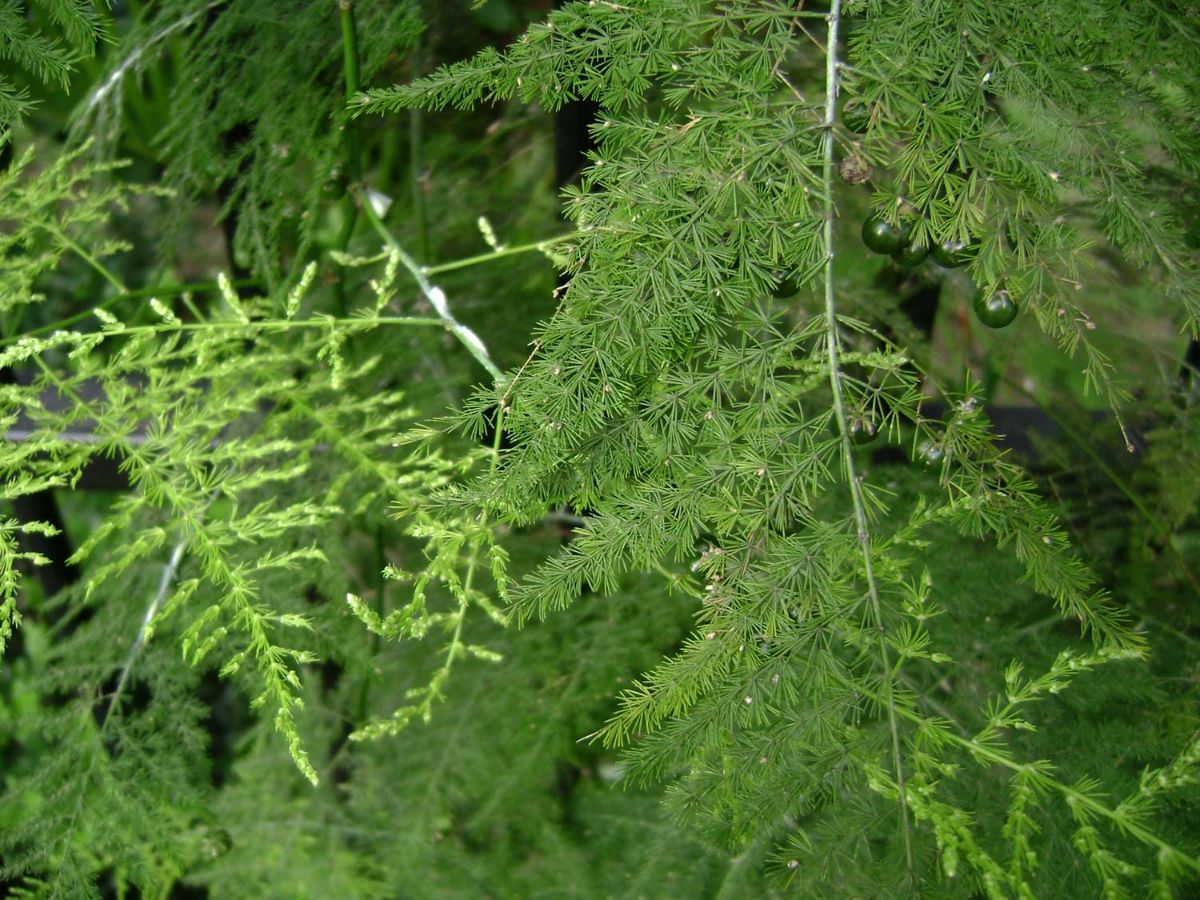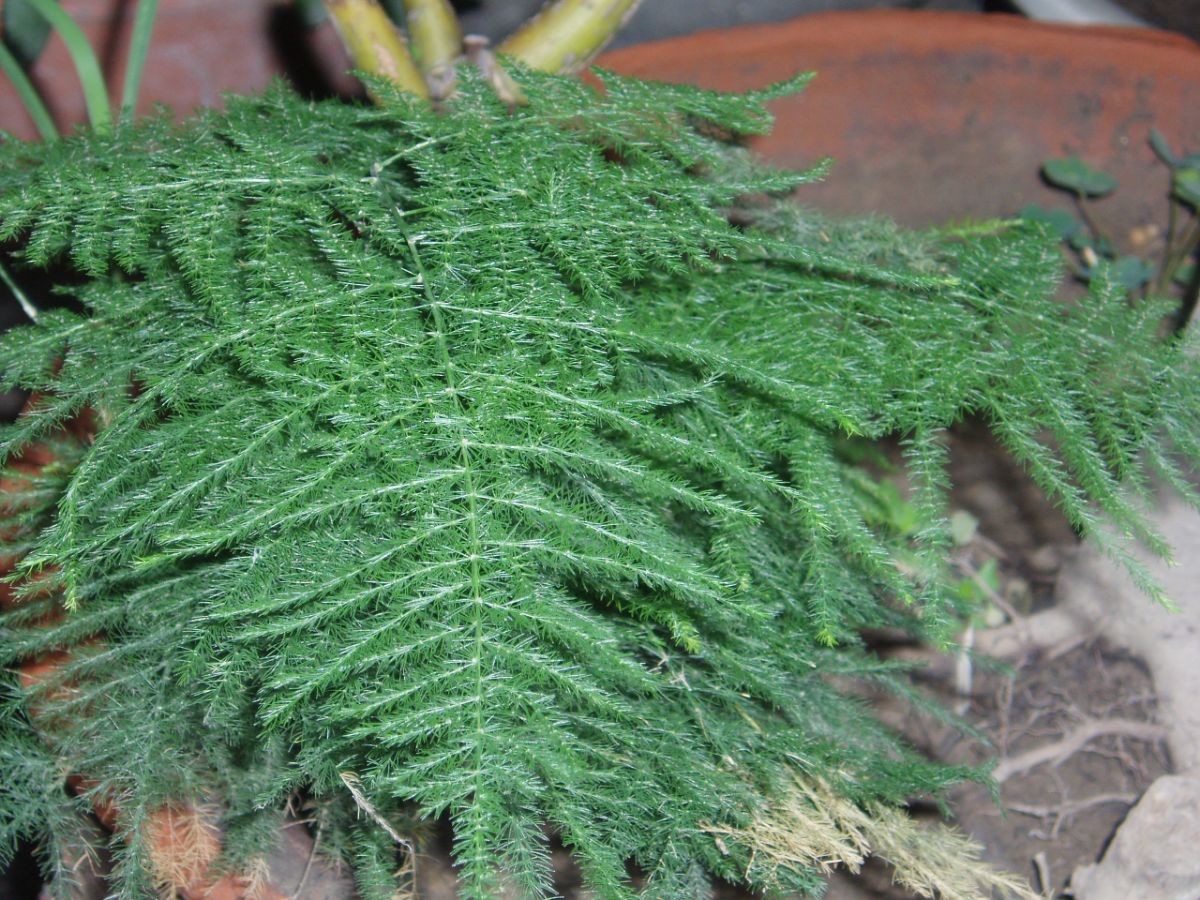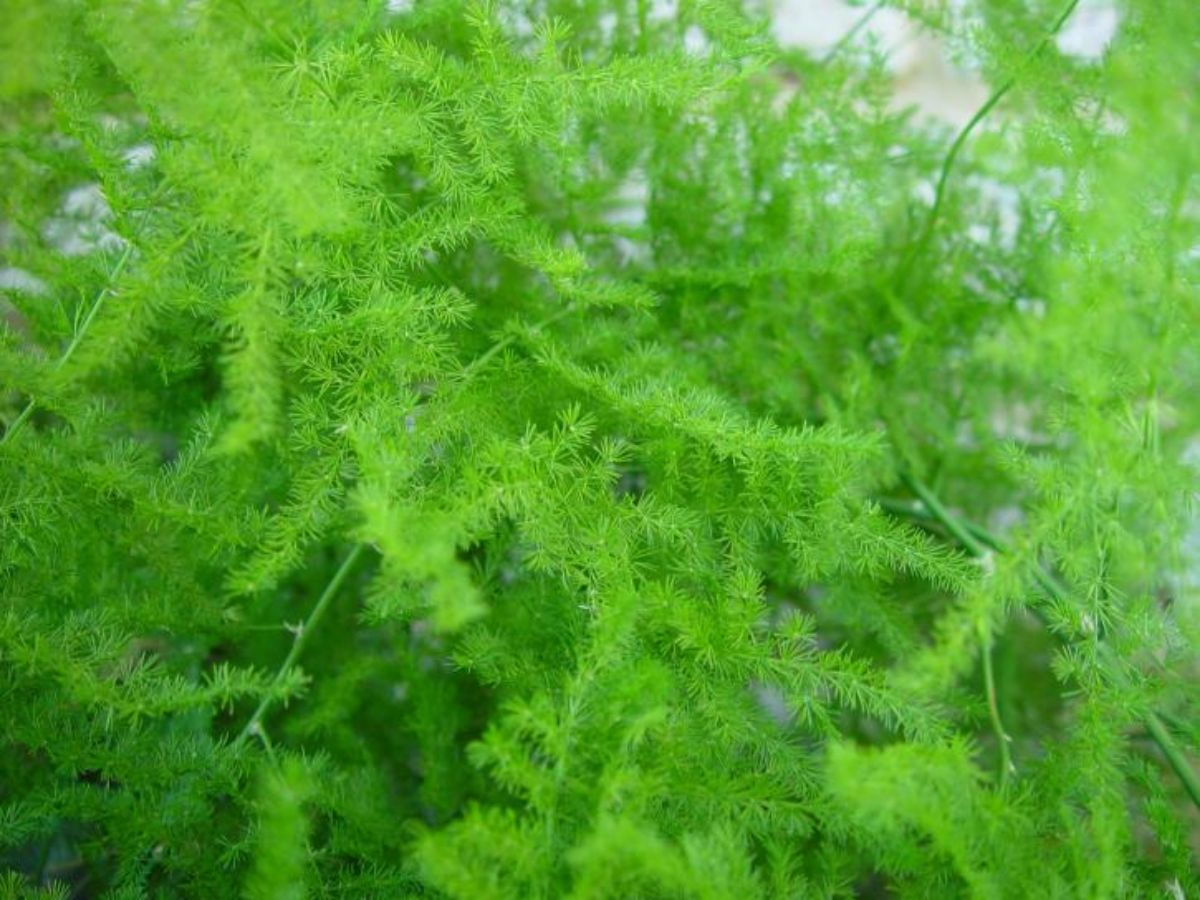
El Asparagus plumosus It is one of the plants native to South Africa that is best adapted to living inside homes. It has very fine stems that give it a very decorative feathery appearance, to the point that many might think that it is actually a fern. But no, isn't it? .
In florists it is widely used as a filler to make bouquets., but at home you can have it in a pot, for example, as a centerpiece.
Characteristics of the Asparagus plumosus

This is one decorative evergreen climbing plant known as florists' asparagusIt is native to South Africa. Its scientific name is Asparagus setaceus (formerly Asparagus plumosus), and it is characterized by having highly branched stems, with acicular leaves that are located in the same plane as the lateral branches, which is what gives it the appearance of a fern frond.
All the flowers, which sprout in summer, measure 0,4cm and are whitish in color. They are not very showy. The fruit is a green berry that turns black when ripe. This is very toxic and should not be eaten.
How do you take care of yourself?

How can you have this plant as beautiful as the first day? Find out what their cares are:
Location
It has to be in a very bright room.
Actually, you can have it both inside the house (where you should place it in the area where more light gives the plant) whatever, although in this case it is better in a more shady place.
If the plant does not get light, you risk that it will grow longer than necessary (because it is looking for light) and that causes its size and density to be lost.
What happens outside to not be in full sun? The asparagus can withstand it, it's not that it can't; but the sun will affect the green of its foliage, turning it yellow, and that makes it look sick or inconspicuous. For this reason, a semi-shaded area is recommended.
Irrigation
During the summer it should be watered very frequently, three or four times a week; the rest of the year you have to reduce the frequency.
La Asparagus plumosus plant requires almost constant water. And it is that it loves to keep the earth moist in order to survive. But that does not mean that it cannot withstand the drought; it will, only it will slow down the growth (to the point of standing still).
In general, so that you know how to do it, we leave it to you:
- Summer: 3-4 times a week.
- Winter: it can be once a week, but if it's cold, you can water it every 10-15 days only.
Keep in mind that it also needs humidity, and it is very grateful that you spray water on it because it loves it.
Substratum
It is not demanding, but it is advisable that it has good drainage. For example, you could use a universal substrate mixed with perlite, akadama or vermiculite, as these will give the earth the oxygenation it needs to feel more comfortable.
At the same time, that drainage can also serve as a moisture retainer. Of course, depending on the one you choose, you will have more or less (the akadama, for example, absorbs moisture very well and keeps the plant moist, but the vermiculite and perlite retain less and that means watering it more often).
Subscriber
During the spring and summer should be fertilized with a universal fertilizer for green plants. It is not advisable to abuse it, so it is recommended that you use it only once every fifteen days to achieve results.

Pruning
Remove dry branches, and cut back those that have grown too much. Basically that is what you would have to do so that your asparagus stays healthy throughout the year.
In addition, you don't have to wait for a certain time to prune it; can be done throughout the year.
Of course, to remove the dry stems, you should cut them as low as possible (touching the ground) because that way they will avoid spending energy on coming out again.
You should also know that if an Asparagus plumosus dries up, which can happen, it does not mean that it has died. In this case, to revive it, a drastic pruning is done. Why is it called that way? Because you must take a good scissors and cut each and every one of the stems as low as possible (at ground level).
Next, if you had it in a pot, you should take it and put it in a container full of water (immersion irrigation). You have to wait for the plant to soak very well, for bubbles to stop coming out, to remove it.
Once you have it outside, let it release excess water and place it in a room where temperatures do not drop below 13 degrees. It has to be a cool place.
In a few weeks you will have new shoots and you will recover your plant.
Transplant
Every two-three years. Repotting is necessary, and you also get more plant growth in return.
Now, can be done in two different ways:
- You can transplant it every year for 4-5. This is done with young specimens to encourage growth and make it bloom faster and better.
- You can transplant it every 2-3 years, normally when you see that the roots begin to come out of the hole in the pot and that their growth has also stopped (no new stems grow).
Be that as it may, you must bear in mind that you will need a slightly larger pot each time. When transplanting it, our recommendation is as follows:
- Let the soil dry out a bit. In this way it will be easier for you to remove the Asparagus plumosus from the pot. Of course, if despite pulling they do not come out, do not force it, it is better to break the pot.
- Next, with a stick, you should try to remove as much soil as possible. This is done to eliminate the one that is no longer worth it (because it will not nourish it). Avoid damaging the roots and spend time on this.
- When you have it, it will be time to prepare your new pot, with a drainage base and soil mixed with it. Settle it and cover with soil without weighing it down too much.
- Finally, you will only have to water.
Pests
It can be affected by aphid, Red spider y cottony mealybug.
Of all of them, the red spider is perhaps the most common in asparagus. You can tell it has it if the leaves start to turn yellow and fall off, revealing tiny hairs under the leaves. If that happens to you, it's the red spider. To remedy this, there is nothing better than increasing the humidity of the plant because this insect cannot stand it.
In the case of mealybugs, although it will also yellow the plant, you will be able to see small brown insects on the stems and leaves. It is best to remove them by hand with a little alcohol and spray the plant with a mixture of black soap, hot water and methylated spirits.
Multiplication
By seeds and by division of bushes in spring or summer.
If we use the seed method, we can obtain them when the asparagus blooms. The seeds should always be planted in early spring and in a seedbed.
Put some soil on a drainage layer and put the seeds. Then lightly cover with substrate and water (or spray).
This seedbed should always be in the shade and preferably in a room that maintains a constant temperature of 16 degrees. Also, if you cover it with plastic wrap (making some holes), much better.
As soon as you see that the seeds germinate, you can remove the paper and take them towards the light. And only when you see that they are strong should you plant them in pots.
In case that If you choose to divide the plant, the steps to take are much easier, but you risk a “stopped” season.
The division must be done in spring and you can divide a maximum of 5-6 new plants. Everything will depend on how many stems you want each plant to have.
Rusticity
It is sensitive to cold. The temperature should not drop below 10ºC.
To enjoy your plant? .
Very poor description of the plant hopefully it could be more specific
Good morning.
They gave me a plumosus esparreguera, and I want to make more pots out of it.
The question is, how do I do it so that it does not die, and at what time.
Thank you very much for your advice.
regards
ISABEL
Hello isbael.
It can be divided in spring. To do this you have to remove it from the pot, remove all the soil you can, and with a serrated knife or scissors previously disinfected with alcohol, separate the plants.
Finally, you have to plant them in individual pots and water them with homemade rooting agents.
A greeting.